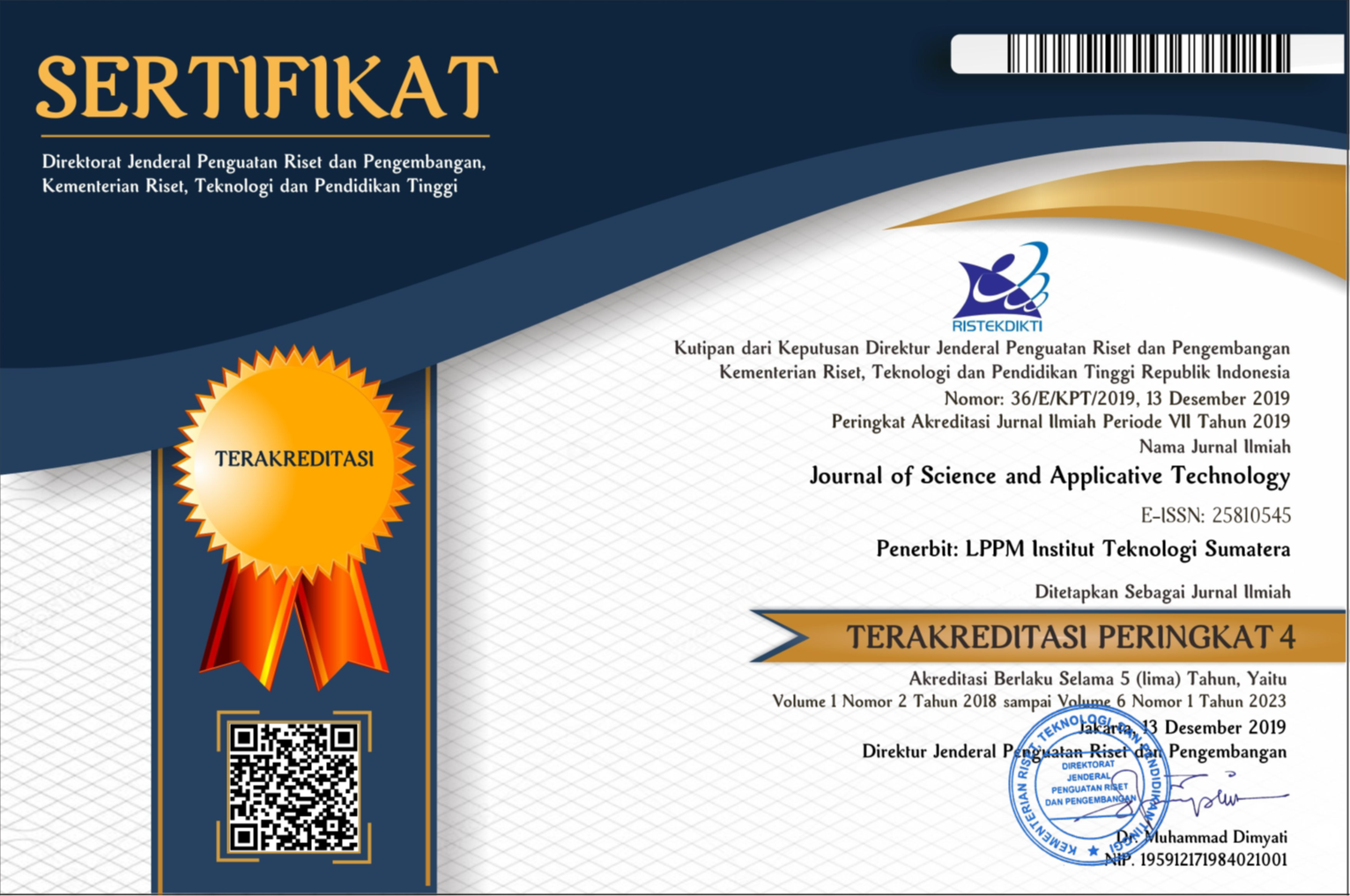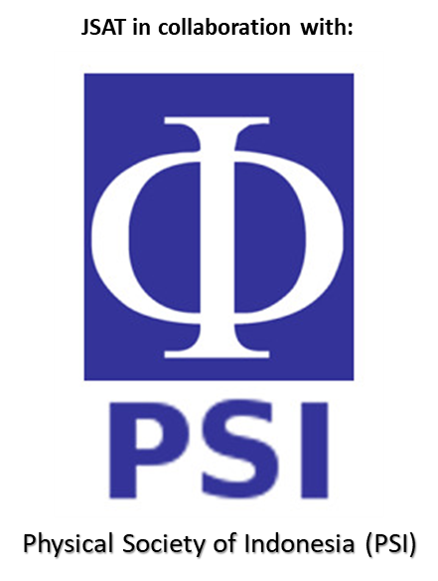Surface Wettability and Colour Change of Betung Bamboo Strands Treated with 1% NaOH under Various Immersing Times
Abstract
Bamboo was a material with enormous potential to be used as raw material for various purposes. This material has good properties for structural purposes such as buildings and furniture or converted to a composite product such as bamboo oriented strand board (BOSB). This study was aimed to determine the wettability properties and the colour change of Dendrocalamus asper bamboo strands after alkali immersing treatment with 1% NaOH solution. The treatments were carried out for 1, 2, and 3 hours, respectively. The wettability of surfaces is quantified by computing the value of the K parameter or the contact angle change rate constant. Meanwhile, the colour change parameter of bamboo strands was quantified by portable colour difference meter CDX – 105 to determine the brightness intensity of a combination of red–green and blue-yellow. The results show that the wettability properties of bamboo strands were getting better after the treatments. On the other hand, the bamboo strands' colour was darker due to the alkali immersion treatment. The optimum duration of alkali immersing treatment with 1% NaOH was 2 hours.
Downloads
References
[2] BADAN PUSAT STATISTIK, STATISTIK PRODUKSI KEHUTANAN STATISTICS OF FORESTRY PRODUCTION 2020. Jakarta: Badan Pusat Statistik, 2021.
[3] F. Febrianto, I. Sumardi, W. Hidayat, and S. Maulana, “Papan untai bambu berarah: Material unggul untuk komponen bahan bangunan struktur.” IPB Press, Bogor, 2017, [Online]. Available: http://repository.lppm.unila.ac.id/2083/.
[4] R. Davinsy et al., “Sifat Fisis dan Mekanis Oriented Strand Board Hibrida Bambu Pada Berbagai Shelling Ratio (Physical and Mechanical Properties of Hybrid Bamboo Oriented Strand Board at Various Shelling Ratios),” J. Ilmu dan Teknol. Kayu Trop., vol. 17, no. 2, pp. 152–159, 2021, doi: 10.51850/jitkt.v17i2.473.
[5] S. Maulana et al., “Destructive and non-destructive tests of bamboo oriented strand board under various shelling ratios and resin contents,” J. Korean Wood Sci. Technol., vol. 47, no. 4, pp. 519–532, 2019, doi: 10.5658/WOOD.2019.47.4.519.
[6] S. Maulana, I. Sumardi, N. J. Wistara, N. H. Kim, and F. Febrianto, “Effects of compression ratio on physical and mechanical properties of bamboo oriented strand board,” IOP Conf. Ser. Mater. Sci. Eng., vol. 935, no. 1, pp. 0–2, 2020, doi: 10.1088/1757-899X/935/1/012063.
[7] Structural Board Association, OSB Design Manual: Construction Sheathing and Design Rated Oriented Strand Board. Ontario: Structural Board Association, 2004.
[8] S. Maulana et al., “Properties of dual-species bamboo-oriented strand boards bonded with phenol formaldehyde adhesive under various compression ratios,” BioResources, vol. 16, no. 3, pp. 5422–5435, Jun. 2021, doi: 10.15376/biores.16.3.5422-5435.
[9] J. Jin et al., “Decay Resistance of Bamboo Oriented Strand Board Pretreated with Copper-based Preservatives,” BioResources, vol. 11, no. 1, pp. 1541–1553, 2016.
[10] F. Ferro, L. Dos Santos, T. Almeida, F. Icimoto, and F. R. Lahr, “Performance of OSB with different Preservative treatments to dry wood termites attack,” 2016. [Online]. Available: https://www.researchgate.net/publication/307608100.
[11] W. Hidayat, C. Anne, and F. Febrianto, “Physical, Mechanical, and Durability Properties of OSB Prepared from CCB Treated Fast Growing Tree Species Strands Bond Quality of Laminated Wood Made from Surian (Toona sinensis Roem) and Sengon (Paraserianthes falcataria (L.) Nielsen) View project quali,” [Online]. Available: https://www.researchgate.net/publication/271139354.
[12] S. Maulana, B. D. Purusatama, N. J. Wistara, and I. Sumardi, “Pengaruh Perlakuan Steam pada Strand dan Shelling Ratio terhadap Sifat Fisis dan Mekanis Oriented Strand Board Bambu ( Effect of Steam Treatment on Strand and Shelling Ratio on the Physical and Mechanical Properties of Bamboo Oriented Strand Board ),” J. Ilmu Teknol. Kayu Trop., vol. 14, no. 2 Juli 2016, pp. 136–143, 2016.
[13] F. Febrianto et al., “Properties of oriented strand board made from Betung bamboo (Dendrocalamus asper (Schultes.f) Backer ex Heyne),” Wood Sci. Technol., vol. 46, no. 1–3, pp. 53–62, Jan. 2012, doi: 10.1007/s00226-010-0385-8.
[14] T. M. R. Hariz et al., “Effects of Resin Content on the Characteristics of Bamboo Oriented Strand Board Prepared from Strands of Betung, Ampel, and Their Mixtures,” J. Sylva Lestari, vol. 9, no. 3, pp. 454–465, Nov. 2021, doi: 10.23960/jsl.v9i3.520.
[15] R. A. Murda, D. S. Nawawi, S. Maulana, M. I. Maulana, S. H. Park, and F. Febrianto, “Perubahan kadar komponen kimia pada tiga jenis bambu akibat proses steam dan pembilasan,” J. Ilmu Teknol. Kayu Trop., vol. 16, no. 2, pp. 102–114, 2018, doi: 10.51850/jitkt.v16i2.446.g372.
[16] M. I. Maulana et al., “Effect of alkali-washing at different concentration on the chemical compositions of the steam treated bamboo strands,” J. Korean Wood Sci. Technol., vol. 49, no. 1, pp. 14–22, 2021, doi: 10.5658/WOOD.2021.49.1.14.
[17] F. Febrianto et al., “Effect of bamboo species and resin content on properties of oriented strand board prepared from steam-treated bamboo strands,” BioResources, vol. 10, no. 2, pp. 2642–2655, 2015, doi: 10.15376/biores.10.2.2642-2655.
[18] A. Fatrawana et al., “Changes in chemical components of steam-treated betung bamboo strands and their effects on the physical and mechanical properties of bamboo-oriented strand boards,” Eur. J. Wood Wood Prod., vol. 77, no. 5, pp. 731–739, 2019, doi: 10.1007/s00107-019-01426-7.
[19] Adrin, F. Febrianto, and S. Sadiyo, “Properties of oriented strand board prepared from steam treated bamboo strands under various adhesive combinations,” J. Ilmu dan Teknol. Kayu Trop., vol. 11, no. 2, pp. 109–119, 2013.
[20] S. Q. Shi and D. J. Gardner, “Dynamic adhesive wettability of wood,” Wood Fiber Sci., vol. 33, no. 1, pp. 58–68, 2001.
[21] R. N. Baiti et al., “Evaluation of surface properties of betung bamboo (Dendrocalmus asper) strands under various heat treatment duration and temperature,” J. Sci. Appl. Technol., vol. 5, no. 2, p. 411, Oct. 2021, doi: 10.35472/jsat.v5i2.457.
[22] R. N. Baiti, S. Maulana, S. U. N. M. Mangurai, R. A. Murda, and Y. Bindar, “Wettability of Dendrocalmus asper under Various Heating Time during Composites Making Process,” IOP Conf. Ser. Earth Environ. Sci., vol. 830, no. 1, 2021, doi: 10.1088/1755-1315/830/1/012012.
[23] W. S. Sipahutar, S. Maulana, S. Augustina, R. A. Murda, and Y. Bindar, “Effects of Heat Treatment on The Wettability and Color Properties of Betung Bamboo (Dendrocalamus Asper) Strand,” IOP Conf. Ser. Earth Environ. Sci., vol. 830, no. 1, p. 012071, Sep. 2021, doi: 10.1088/1755-1315/830/1/012071.
[24] J. Darmanto, Sulardjaka, and A. Suprihanto, “The Effect of Fiber Pretreatment On Physical and Mechanical Properties in Water Hyacinth Fiber Composite,” Int. J. Emerg. Trends Eng. Res., vol. 8, no. 8, pp. 4799–4805, Aug. 2020, doi: 10.30534/ijeter/2020/117882020.
[25] A. C. de Albuquerque, K. Joseph, L. Hecker de Carvalho, and J. R. M. D’Almeida, “Effect of wettability and ageing conditions on the physical and mechanical properties of uniaxially oriented jute-roving-reinforced polyester composites,” Compos. Sci. Technol., vol. 60, no. 6, pp. 833–844, May 2000, doi: 10.1016/S0266-3538(99)00188-8.
[26] G. Cantero, A. Arbelaiz, R. Llano-Ponte, and I. Mondragon, “Effects of fibre treatment on wettability and mechanical behaviour of flax/polypropylene composites,” Compos. Sci. Technol., vol. 63, no. 9, pp. 1247–1254, Jul. 2003, doi: 10.1016/S0266-3538(03)00094-0.
[27] M. Masłowski, J. Miedzianowska, and A. Czylkowska, “Horsetail ( Equisetum Arvense ) as a Functional Filler for Natural Rubber Biocomposites,” 2020.
[28] E. M. Petrie, An Introduction to Adhesive and Sealants. New York: McGraw-Hill, 2007.
[29] K. Witono, Y. Surya Irawan, R. Soenoko, and H. Suryanto, “Pengaruh Perlakuan Alkali (NaOH) Terhadap Morfologi dan Kekuatan Tarik Serat Mendong,” J. Rekayasa Mesin, vol. 4, no. 3, pp. 227–234, 2013.
[30] A. T. Lestari, “SIFAT KETERBASAHAN PADA BIDANG TANGENSIAL DAN RADIAL KAYU RAJUMAS (Duabanga moluccana Blume) Wettability on Tangential and Radial Surface of Rajumas Wood (Duabanga moluccana Blume),” Perennial, vol. 16, no. 1, pp. 7–10, 2020, doi: 10.24259/perennial.v16i1.7638.
[31] S. Q. Shi and D. J. Gardner, “DYNAMIC ADHESIVE WETTABILITY OF WOOD,” Wood Fiber Sci., vol. 33, no. 1, pp. 58–68, 2001.
[32] A. Roy, S. Chakraborty, S. P. Kundu, R. K. Basak, S. Basu Majumder, and B. Adhikari, “Improvement in mechanical properties of jute fibres through mild alkali treatment as demonstrated by utilisation of the Weibull distribution model,” Bioresour. Technol., vol. 107, pp. 222–228, Mar. 2012, doi: 10.1016/j.biortech.2011.11.073.
[33] A. Setiawan et al., “Pengaruh Treatment Alkali Terhadap Karakteristik Fiber Sabut Kelapa Sawit Dan,” vol. 5, no. 2, 2019.
[34] S. Zhang, W. Wang, F. Li, and J. Yu, “Swelling and dissolution of cellulose in NaOH aqueous solvent systems,” Cellul. Chem. Technol., vol. 47, pp. 671–679, 2013.
[35] M. A. Azeez and J. I. Orege, “Bamboo, Its Chemical Modification and Products,” in Bamboo - Current and Future Prospects, InTech, 2018.
[36] C. Piao, J. E. Winandy, and T. F. Shupe, “FROM HYDROPHILICITY TO HYDROPHOBICITY: A CRITICAL REVIEW: PART I. WETTABILITY AND SURFACE BEHAVIOR.”
[37] W. Darmawan, M. B. Ginting, A. Gayatri, R. L. Putri, D. Lumongga, and A. Hasanusi, “Influence of surface roughness of ten tropical woods species on their surface free energy, varnishes wettability and bonding quality,” Pigment Resin Technol., vol. 49, no. 6, pp. 441–447, Oct. 2020, doi: 10.1108/PRT-01-2020-0005.
[38] W. M. N. W. A. Rahman, N. Y. Mohd Yunus, N. S. M. Tamat, and S. N. Sarmin, “Alkaline Treatment on the Chemical and Morphological Properties of Kelempayan (Neolamarckia cadamba) Wood,” Mater. Sci. Forum, vol. 1025, no. November, pp. 319–324, Mar. 2021, doi: 10.4028/www.scientific.net/msf.1025.319.
[39] R. M. Christie, Colour Chemistry 2nd edition, 2nd ed., vol. 2. Cambridge: The Royal Society of Chemistry, 2015.
[40] R. Widyorini, K. Khotimah, and T. A. Prayitno, “Pengaruh Suhu Dan Metode Perlakuan Panas Terhadap Sifat Fisika Dan Kualitas Finishing Kayu Mahoni,” J. Ilmu Kehutan., vol. 8, no. 2, pp. 65–74, 2014.
[41] Y. Li, S. Zhu, Y. Feng, F. Xu, J. Ma, and F. Zhong, “Influence of alkalization treatment on the color quality and the total phenolic and anthocyanin contents in cocoa powder,” Food Sci. Biotechnol., vol. 23, no. 1, pp. 59–63, Feb. 2014, doi: 10.1007/s10068-014-0008-5.
[42] Fakhruzy, “FIBRILASI SELULOSABAMBU AMPEL (Bambussa vulgaris),” Menara Ilmu, vol. 11, no. 79, pp. 227–230, 2018.
Copyright (c) 2022 Journal of Science and Applicative Technology

This work is licensed under a Creative Commons Attribution-NonCommercial 4.0 International License.
All the content on Journal of Science and Applicative Technology (JSAT) may be used under the terms of the Creative Commons Attribution-NonCommercial 4.0 International License.
You are free to:
- Share - copy and redistribute the material in any medium or format
- Adapt - remix, transform, and build upon the material
Under the following terms:
- Attribution - You must give appropriate credit, provide a link to the license, and indicate if changes were made. You may do so in any reasonable manner, but not in any way that suggests the licensor endorses you or your use.
- NonCommercial - You may not use the material for commercial purposes.
- No additional restrictions - You may not apply legal terms or technological measures that legally restrict others from doing anything the license permits.





















